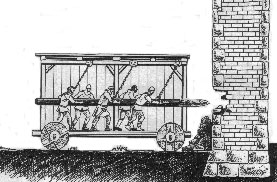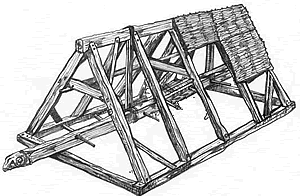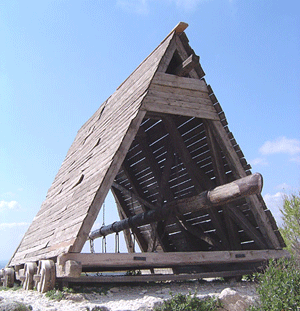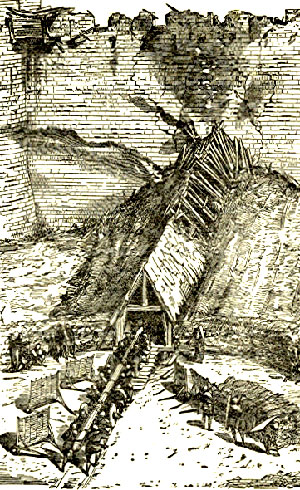Rams
Cats & Sows
Weasels
Tortoises
The Battering Ram
A battering ram is a siege engine originating in ancient times to breach fortification walls or doors. In its simplest form, a battering ram is just a large, heavy log carried by several people and propelled with force against the target, the momentum of the ram damaging the target.
Some battering rams were supported by rollers. This gave the ram much greater travel so that it could achieve a greater speed before striking its target and was therefore more destructive. Such a ram was used by Alexander the Great.
|
In a more sophisticated design, the ram was slung from a wheeled support frame so that it could be much more massive and also more easily swung against its target. Sometimes the ram's attacking point would be reinforced with a metal head. A capped ram is a battering ram that has an accessory at the head (usually made of iron or steel, traditionally shaped into the head and horns of a ram to do more damage to a building. Many battering rams had protective roofs and side-screens covered in materials, often fresh wet hides to prevent the ram being set on fire, as well as to protect the ram's operators of the ram from enemies firing arrows down on them. |
|
| An image of an Assyrian battering ram
shows how sophisticated attack and defence had come
by the 9th century BC. In the image defenders are trying
to set the ram alight with torches and have also put
a chain under the ram. The attackers are trying to pull
on the chain to free the ram - the same scene could
have been depicted in Roman, Visigothic or Medieval
times.
When a castle was being attacked, defenders attempted to foil battering rams by dropping obstacles in front of the ram just before it hit a wall, using grappling hooks to immobilize the log, setting the ram on fire, or sallying out to attack the ram. Battering rams had an important effect on the evolution of defensive walls - the talus for example was one way of reinforcing walls. In practice, wooden gates would generally offer the easiest targets. |
|
|
|
|
Raymondet, the future Raymond VII, Count of Toulouse, used a ram at Beaucaire in 1216. He was himself besieged in the town by Simon de Montfort's Crusader forces, while he himself was besiging the garisson of the castle within the fortified town. The The Song of the Crusade (the Canso) tells us a little about the ram. We know for example that it had an iron head. The poet tels us that it was
|
|
The Cat
|
A Cat was a wooden structure built (or moved) up to a defensive wall. From surviving documents it seems that an arm could manipulated to claw away at the castle wall - hence the name. Cats could be large multi-purpose strucures, perhaps with a trebuchet on top and sappers operating from the protected interior. Cats were much feared and if they possibly could, castle defenders would try to destroy them by mounting sorties, by using stone throwing engines, or by setting fire to them. Like all wooden siege engines they would be routinely covered in the skins of freshly slaughtered animals and regularly dowsed with water to keep them fireproof. Simon de Montfort used a cat at the Siege of Beaucaire in 1216, but unsuccessfully. According to the Canso it had "no more effect than an enchanter's dream". It was "a spider's web and a sheer waste of material". Perhaps the most famous cat was one Simon built two years later, attempting to besiege the City of Toulous in 1217-18. It was while protecting his cat from counter attack by the citizens of Toulouse that Simon de Montfort was struck on the head by a massive stone projectile from a trebuchet on the city walls, and killed instantly.
|
|
The Weasel
|
A weasel was a similar sort of structure to a cat, but smaller and lighter. It seems to have been more manoeuverable and used a spike rather than a paw to attack castle walls. It may have taken its name from its business end looking like a weasel's note, or perhaps its long thin body, or both. A weasel was used by the forces of Raymondet, the future Count Raymond VII of Toulouse, at Beaucaire in 1216 according to the The Song of the Crusade (Canso de la crozada). As Simon de Montfort was conducting a Council of War, a beggar burst in, shouting that he had seen a weasel. The weasel was already against the citadel wall and ready to drive a spike into it. The defenders were quick to react. The chief engineer hurled a pot of molten pitch at it, hitting it in exactly the right spot and it burst into flames.
|
|
The Tortoise












